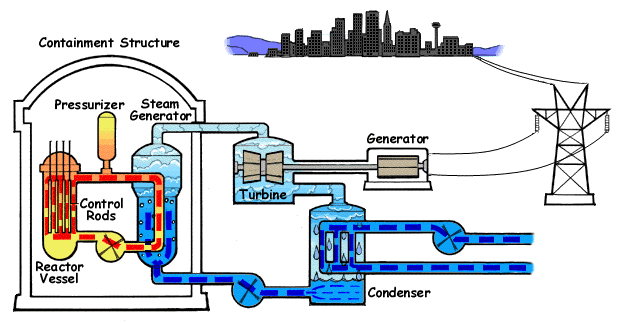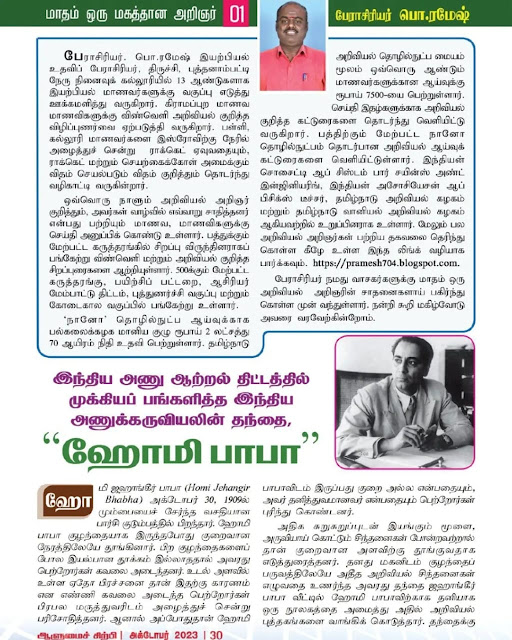Today (January 24, 1966) is the Memorial Day of Homi Bhabha, the father of Indian nuclear science, who made a significant contribution to the Indian nuclear program.

Homi Jehangir Bhabha was born on
October 30, 1909, in a comfortable Parsi family in Mumbai. Homi Bhabha fell
asleep in less time when he was a child. His parents were worried about the
lack of normal sleep like other children. Concerned parents took him to a
reputable doctor for a check-up, thinking it was a physical problem. But only
then did the parents realize that Homi Bhabha's presence was not inferior and
that he was unique. They suggested that they sleep less because of more active
brainwashing thoughts. Realizing that his son had been obsessed with science
since childhood, Jahangir Bhabha set up a separate library of Homi Bhabha at
home and bought science books in it. The father had a desire that his son should
develop into a better engineer. But Bhabha wanted to become a better physicist.
At an early age, he finished reading all the science books in the home library.

Bhabha's father sent him to
England to make him an engineer. He left Cambridge in 1927
to study engineering at his father's request. After graduating from high school
in 1930, Bhabha joined the research department as a research student in the
field of theoretical physics. Homi Bhabha undertook various studies that marked
a turning point in his life to pursue his higher studies as a research student
in physics as he travelled towards his dreams after fulfilling his father’s
wish. I had the opportunity to get acquainted with many of the world's foremost
scientists in the UK. Rutherford, one of the so-called fathers of physics,
discovered the existence of proton particles. He also befriended great
scientists such as Drake, Niels Bohr, and Heidler. Homi Bhabha your thoughts
flourished further. He worked with eminent physicists such as Enrico Fermi and
Wolfgang Pauly.

In 1933, Isaac Newton was awarded
a scholarship for his scientific paper on the role of electron precipitation in
the absorption of gamma rays. He received his doctorate in 1934. In 1937, Homi
and Heidler, a German physicist, made a world-famous study of cosmology. Homi Bhabha,
who also played a key role in research with leading physicists, published his
calculations on electron-positron scattering in 1935. The department was
later renamed Bhabha Skating in honour of his research. In addition, further
research revealed that a fundamental particle called meson was present in the
galaxy. He also showed evidence for Einstein's theory of relativity by studying
Meson's motion. This mezzanine testimonial is very popular. He returned to
India in 1939 to rest for a while after a series of scientific studies.


Pandit Jawaharlal Nehru was proud
to be the first Prime Minister of the country for the development of the Indian
science sector and to make progress in various fields in India. In that sense, Bhabha
was one of the intellectuals who gave the advice to guide independent India on the
path of development. Even after spending hours discussing various matters with Bhabha,
Nehru's daughter Indira Gandhi has mentioned her close friendship with Bhabha
on various occasions. Bhabha, who laid the foundation for the emergence of
eminent scientists at the Indian Science Training Center, was the first to
study the production of uranium isotopes and the refining of uranium in India,
travelling towards his next goals in physics and research. It was Bhabha's
serious initiative that led to the launch of the first nuclear research centre
in India. Launched in 1945 in Mumbai as the Tata Basic Research Center, the
research centre was initially housed in a small rented building. He stressed
the need for India to rise in the nuclear field when India gained independence
in 1947. Bhabha maturely said that nuclear power generation and the nuclear bomb
would showcase India's strength to the world.


The Atomic Energy Commission of
India was established in 1948 at the initiative of Bhabha. Homi Bhabha took
charge as its chairman. From then until he died in 1966, he served as the
Chairman of the Atomic Energy Commission of India for 18 years. It was during
this period that the Bhabha Atomic Energy Research Center in Mumbai was
established. The foundations were also laid for the construction of nuclear
power plants in various parts of the country. Bhabha made the world look back
at India by proposing thorium as an alternative to the uranium used as fuel by
the nations of the world to gain power. With foresight, he calculated the
country's uranium depletion and thorium abundance and developed three steps to
generate electricity from thorium. This is the foundation for India to move
towards self-sufficiency in the nuclear sector.



Although Homi Bhabha did not
receive the Nobel Prize, he is proud to have been nominated for it 5 times. In
1954, the Government of India honoured him with the Padma Bhushan, the third
largest award in the country. He is the recipient of the Royal Society's Fellowship
Award for world-renowned scientific geniuses such as Isaac Newton, Charles
Darwin and Michael Faraday. Homi J Bhabha chaired the first meeting of an
international conference organized by the United Nations in Geneva to discuss
how to use nuclear energy creatively. How he conducted this
seminar and how he encouraged the use of nuclear energy for
creative purposes has earned him great respect internationally. In Geneva, he
effectively argued that nuclear power could be used peacefully, given the
perception that nuclear power was destructive. A scientist does not belong to
any nation. They are the ones who strive for mankind for the world. Bhabha
often said that the doors of the scientific world should remain open. Atomic
physicist Homi Bhabha, a key contributor to India's nuclear program, died on
January 24, 1966, at the age of 56, when his plane crashed while attending an
international conference.
Source By: Wikipedia
Information: Ramesh, Assistant
Professor of Physics, Nehru Memorial College, Puthanampatti, Trichy.
Get information like this
https://t.me/joinchat/jpqj3jQLN51kYTk9
Join Telegram Group.
https://chat.whatsapp.com/FisIzCe4Br2CRgxAiicUnf
Join WhatsApp Group
Thanks.
Also, Read
🛑👍 CSIR-NET Physics Materials and Problems
🛑📕 21 GB and Hundreds of Physics E-Books Collection.
🛑🛥️ How does an Electric Motor work? (DC Motor).
🛑🤹♂️ Science Academies' Summer Research Fellowship Programme for Students and Teachers 2022.
🛑🔌 How does a Transformer work - Working Principle electrical engineering.
🛑🎙️ Transistors Explained - How transistors work.
🛑🔥⚡ How Thermocouples Work - basic working principle.
🛑🔌 Voltage Explained - What is Voltage? Basic electricity potential difference
🛑🔌 What is CURRENT– electric current explained, electricity basics.

.jpeg)
.jpeg)
.jpeg)



No comments:
Post a Comment